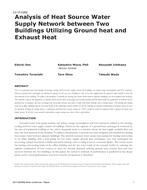Description
The use of ground source heat pumps in heating, cooling and hot water supply systems for buildings can reduce energy consumption and CO2 emissions.However, ground heat exchangers are limited in capacity by the area of a building or site, so the heat supply from the ground is often unable to meet theheat demand of the building. To address this problem, a network for sharing heat source water between adjacent buildings has been designed and installed.The network connects the equipment as thermal loads (water source heat pumps for heating/cooling and hot water) with the equipment as thermal sources(ground heat exchangers, two heat exchangers for recovering exhaust heat from a chiller and boiler backup, and a cooling tower). The heating and coolingloads of an office building and the hot water loads of the adjoining research facility are met by selecting an optimal combination of thermal sources to meetthe demand. During the design phase, a simulation predicted that energy savings of 33.4% would be achieved compared with a typical air-source heatpump system. In the first seven months of operation, energy savings were close to these expectations.
Citation: 2017 Winter Conference, Las Vegas, NV, Conference Papers
Product Details
- Published:
- 2017
- Number of Pages:
- 8
- Units of Measure:
- Dual
- File Size:
- 1 file , 950 KB
- Product Code(s):
- D-LV-17-C002




